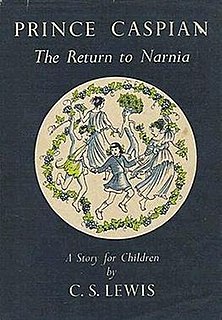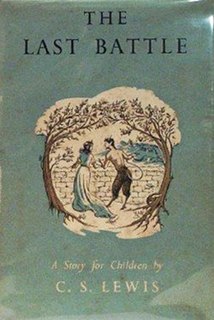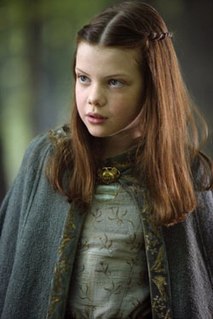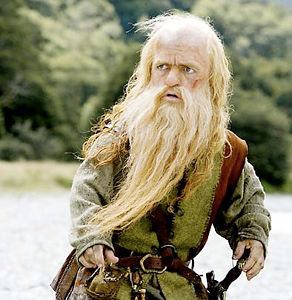Illustrations
Narnian creatures that are not mentioned in The Magician's Nephew but can be seen in the original ink illustrations by Pauline Baynes include antelopes, bisons, camels, Cape buffaloes, chickens, cobras, crocodiles, cranes, dolphins, ducks, ferrets, frogs, flamingos, gazelles, Geese, giraffes, goats, herons, hippopotamuses, hornbills, hyenas, lemurs, lizards, llamas, monkeys, mongoose, moose, otters, ostrichs, pandas, parrots, penguins, porcupines, puffins, raccoons, rats, sharks, shrews, skunks, snakes, storks, turkeys, warthogs, weasels, whales, yaks, and zebras. An Ipotane that was meant to be a Centaur can be seen in one of the illustrations in The Lion, the Witch, and the Wardrobe .
Unidentifiable mythical creatures are listed below:
- Dragon/bull creature - In one of the illustrations of The Lion, the Witch, and the Wardrobe, there is a monster with a bull's body, webbed dragon forepaws, and large dragon wings. It fights in the White Witch's army.
- Minotaur/centaur creatures - In two illustrations of The Lion, the Witch, and the Wardrobe, there is a centaur creature with bull's horns in the White Witch's courtyard when Aslan frees the statues back into Narnians.
- Hamadryad creatures - In illustrations of Magician's Nephew and The Lion, the Witch, and the Wardrobe, respectively, the oak, requested by Aslan to attend the council, appears as a walking tree with a human face; and in the scene when Aslan revives the statues, there are several tree women who appear as trees with human shaped heads on their trunks and branches for arms, and branches growing out of their heads. These may have been meant to be hamadryads.
- Vulture/dragon/man monster - In one of the illustrations of The Lion, the Witch, and the Wardrobe, a faun fights an odd sort of monster from the White Witch's army. It has the body and stature of a man, but has the head of a vulture and the hind legs and tail of a dragon. It may be an inspiration for the physical appearance of the character Tash.

The Chronicles of Narnia is a series of seven fantasy novels by C. S. Lewis. Written by Lewis, illustrated by Pauline Baynes, and originally published in London between 1950 and 1956, The Chronicles of Narnia has been adapted for radio, television, the stage, and film. The series is set in the fictional realm of Narnia, a fantasy world of magic, mythical beasts, and talking animals. It narrates the adventures of various children who play central roles in the unfolding history of the Narnian world. Except in The Horse and His Boy, the protagonists are all children from the real world who are magically transported to Narnia, where they are sometimes called upon by the lion Aslan to protect Narnia from evil. The books span the entire history of Narnia, from its creation in The Magician's Nephew to its eventual destruction in The Last Battle.

Prince Caspian is a high fantasy novel for children by C. S. Lewis, published by Geoffrey Bles in 1951. It was the second published of seven novels in The Chronicles of Narnia (1950–1956), and Lewis had finished writing it in 1949, before the first book was out. It is volume four in recent editions of the series, sequenced according to the internal chronology of the books. Like the others, it was illustrated by Pauline Baynes and her work has been retained in many later editions.

Narnia is a fantasy world created by C. S. Lewis as the primary location for his series of seven fantasy novels for children, The Chronicles of Narnia. The world is so called after the country of Narnia, in which much of the action of the Chronicles takes place.

The Last Battle is a high fantasy novel for children by C. S. Lewis, published by The Bodley Head in 1956. It was the seventh and final novel in The Chronicles of Narnia (1950–1956). Like the other novels in the series, it was illustrated by Pauline Baynes and her work has been retained in many later editions.

Jadis is the main antagonist of The Magician's Nephew and of The Lion, the Witch and the Wardrobe in C. S. Lewis's series, The Chronicles of Narnia. She is commonly referred to as the White Witch in The Lion, the Witch and the Wardrobe, as she is the Witch who froze Narnia in the Hundred Years Winter.

Lucy Pevensie is a fictional character in C. S. Lewis's The Chronicles of Narnia series. She is the youngest of the four Pevensie children, and the first to find the Wardrobe entrance to Narnia in The Lion, the Witch and the Wardrobe. Of all the Pevensie children, Lucy is the closest to Aslan. Also, of all the humans who have visited Narnia, Lucy is perhaps the one that believes in Narnia the most. She is ultimately crowned Queen Lucy the Valiant, co-ruler of Narnia along with her two brothers and her sister. Lucy is the central character of the four siblings in the novels. Lucy is a principal character in three of the seven books, and a minor character in two others.

Peter Pevensie is a fictional character in C. S. Lewis's The Chronicles of Narnia book series. Peter appears in three of the seven books; as a child and a principal character in The Lion, the Witch and the Wardrobe and Prince Caspian, and as an adult in The Last Battle. He is only mentioned in The Horse and His Boy in which he is away on the northern frontier fighting giants and in The Voyage of the Dawn Treader in which he is studying under the tutelage of Professor Kirke.

The Chronicles of Narnia: Prince Caspian is a 2008 high fantasy film co-written and directed by Andrew Adamson, based on Prince Caspian, the second published, fourth chronological novel in C. S. Lewis's epic fantasy series, The Chronicles of Narnia. It is the second in The Chronicles of Narnia film series from Walden Media, following The Chronicles of Narnia: The Lion, the Witch and the Wardrobe (2005). William Moseley, Anna Popplewell, Skandar Keynes, Georgie Henley, Liam Neeson, and Tilda Swinton reprise their roles from the first film, while new cast includes Ben Barnes, Sergio Castellitto, Peter Dinklage, Eddie Izzard, Warwick Davis, Ken Stott, and Vincent Grass. In the film, the four Pevensie children return to Narnia to aid Prince Caspian in his struggle with the "secret" help of Aslan for the throne against his corrupt uncle, King Miraz.
Lantern Waste is a fictional place in The Chronicles of Narnia series by C. S. Lewis. It is a wood and is notable as the place where Lucy Pevensie and Mr. Tumnus meet, which is the first scene of Narnia described in the books. The lamppost in the wood is an iconic image of Narnia, and the question of its origin is what convinced Lewis to write more than one book on Narnia. One of King Edmund's titles is Duke of Lantern Waste.[PC]
In C. S. Lewis's fantasy novel series the Chronicles of Narnia, the hill of the Stone Table, or Aslan's How, is a high mound or cairn south of the Great River in Narnia next to the Great Woods. The How was built over the hill of the Stone Table. The word how derives from the Old Norse haugr, meaning hill or mound. In parts of England, it is a synonym for barrow.

The First Battle of Beruna is a fictional battle in C. S. Lewis' fantasy series The Chronicles of Narnia. It is fought in Narnia at the edges of the Great River near the Fords of Beruna, in the year 1000 according to Lewis' Narnian timeline. It is the climactic battle of The Lion, The Witch and The Wardrobe and one of several battles in the Chronicles of Narnia.

The Chronicles of Narnia is a British BBC-produced television serial that was aired from 13 November 1988 to 23 December 1990 and is based on four books of C. S. Lewis's The Chronicles of Narnia series. The first series aired was The Lion, the Witch and the Wardrobe in 1988, the second series aired was Prince Caspian and The Voyage of the Dawn Treader in 1989 and the third series aired was The Silver Chair in 1990. This television serial was produced by Paul Stone and teleplayed by Alan Seymour. The Lion, the Witch, and the Wardrobe was directed by Marilyn Fox, while Prince Caspian, The Voyage of the Dawn Treader and The Silver Chair were directed by Alex Kirby.

Trumpkin is a fictional character in C. S. Lewis' fantasy novel series The Chronicles of Narnia. Trumpkin is an intensely practical and skeptical dwarf who lives during the reigns of King Miraz and King Caspian X. He is a major character in Prince Caspian, briefly mentioned in The Voyage of the Dawn Treader, and is a minor character in The Silver Chair.
The Second Battle of Beruna is a fictional battle in C.S. Lewis's fantasy series The Chronicles of Narnia between the "Old Narnians" and the Telmarines of Narnian. It is one of several battles in the Chronicles of Narnia.

Aslan is a major character in C. S. Lewis's The Chronicles of Narnia series. He is the only character to appear in all seven books of the series. C.S. Lewis often capitalises the word lion in reference to Aslan since he parallels Jesus Christ.

Maugrim is a fictional character in the novel The Lion, the Witch and the Wardrobe by C. S. Lewis. A Narnian wolf, he is the Captain of the White Witch's Secret Police. In early American editions of the book, Lewis changed the name to Fenris Ulf, but when HarperCollins took over the books they took out Lewis' revisions, and the name Maugrim has been used in all editions since 1994.
C. S. Lewis' fantasy series The Chronicles of Narnia includes several battles set in Narnia, Archenland, and other places in the Narnian World. These are given below in an in-universe, fictional chronology while listing them in order of appearance
The following outline is provided as an overview of and topical guide to Narnia:












